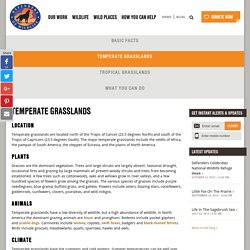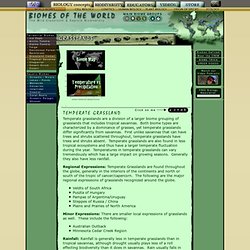

Dogbane. Jon pye weed. Tallgrass. Shortgrass. Ironweed. Temperate Grasslands. Location Temperate grasslands are located north of the Tropic of Cancer (23.5 degrees North) and south of the Tropic of Capricorn (23.5 degrees South).

The major temperate grasslands include the veldts of Africa, the pampas of South America, the steppes of Eurasia, and the plains of North America. Plants Grasses are the dominant vegetation. Trees and large shrubs are largely absent. Animals Temperate grasslands have a low diversity of wildlife, but a high abundance of wildlife.
Climate Temperate grasslands have hot summers and cold winters. Soil Temperate grasslands have soils that are nutrient-rich from the growth and decay of deep, many-branched grass roots. Threats. Temperate Grasslands. Map. Grassland. Grasslands. Location | Weather | Plants | Animals | People | Links LOCATION: The name for this biome, temperate grasslands, is a great description for what it is like here.

The most important plants in this biome are grasses! Temperate grasslands have some of the darkest, richest soils in the world (not in wealth, but in nutrients). People who live in grassland regions often use these soils for farming. WEATHER: Temperatures in this biome vary greatly between summer and winter. PLANTS: Grasses dominate temperate grasslands. ANIMALS: All grasslands share a lack of shelter from predators, and an abundance of grass for food; therefore, grassland animal populations are similar throughout the world. Grasslands info. Grassland biomes are large, rolling terrains of grasses, flowers and herbs.

Latitude, soil and local climates for the most part determine what kinds of plants grow in a particular grassland. A grassland is a region where the average annual precipitation is great enough to support grasses, and in some areas a few trees. The precipitation is so eratic that drought and fire prevent large forests from growing. Grasses can survive fires because they grow from the bottom instead of the top. Their stems can grow again after being burned off. When the settlers of the United States moved westward, they found that the grasslands, or prairies as they called them, were more than just dry, flat areas. There are two different types of grasslands; tall-grass, which are humid and very wet, and short-grass, which are dry, with hotter summers and colder winters than the tall-grass prairie. Temperate Grasslands Biome. Temperate grasslands are a division of a larger biome grouping of grasslands that includes tropical savannas.

Both biome types are characterized by a dominance of grasses, yet temperate grasslands differ significantly from savannas. First unlike savannas that can have trees and shrubs scattered throughout, temperate grasslands have trees and shrubs absent. Temperate grasslands are also found in less tropical ecosystems and thus have a larger temperate fluctuation during the year. Temperatures in temperate grasslands can vary tremendously which has a large impact on growing seasons. Generally they also have less rainfall. Regional Expressions: Temperate Grasslands are found throughout the globe, generally in the interiors of the continents and north or south of the tropic of cancer/capercorn.
Veldts of South Africa Puszta of Hungary Pampas of Argentina/Uruguay Steppes of Russia / China Plains and Prairies of North America Australian Outback Minnesota Cedar Creek Region Text is temporary. Temperate Grasslands. Grasslands. Grasslands go by many names.

In the U.S. Midwest, they're known as prairies. In South America, they're called pampas. Central Eurasian grasslands are referred to as steppes, while in Africa they're named savannas. What they all have in common is grass as their naturally dominant vegetation. Grassland Biome Facts. The grassland biome. Online exhibits : The world's biomes The grassland biome Grasslands are characterized as lands dominated by grasses rather than large shrubs or trees.

In the Miocene and Pliocene Epochs, which spanned a period of about 25 million years, mountains rose in western North America and created a continental climate favorable to grasslands. Ancient forests declined and grasslands became widespread. Following the Pleistocene Ice Ages, grasslands expanded in range as hotter and drier climates prevailed worldwide. Savanna Savanna is grassland with scattered individual trees.
The soil of the savanna is porous, with rapid drainage of water. Savanna has both a dry and a rainy season. Animals. Groundhogs. Coyote. Pronghorn. Wolf. Cows.